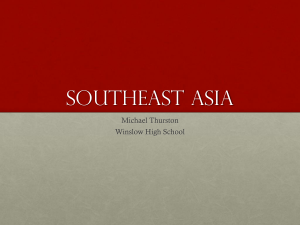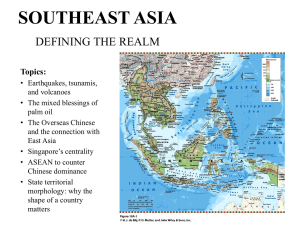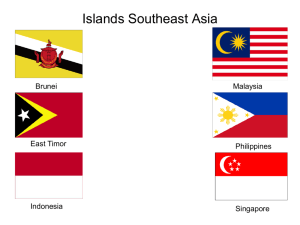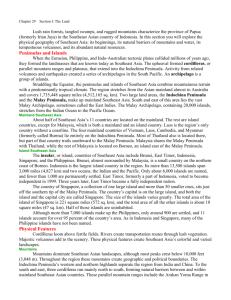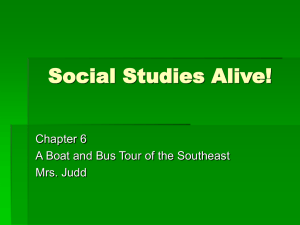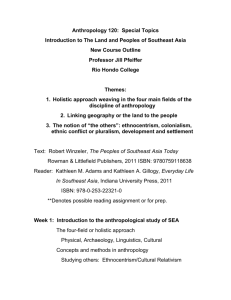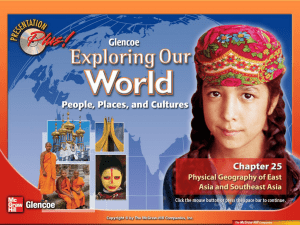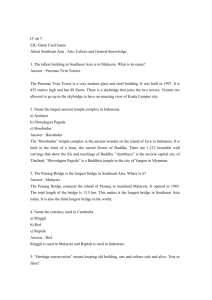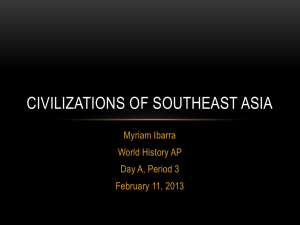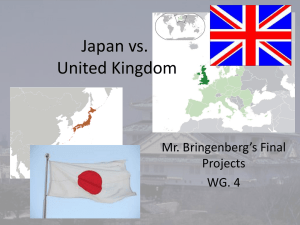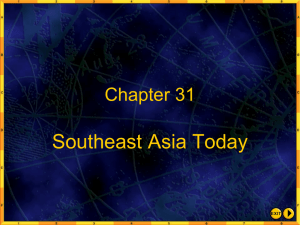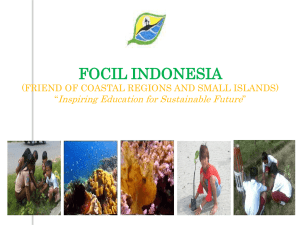Chapter 29 - Gainesville ISD
advertisement
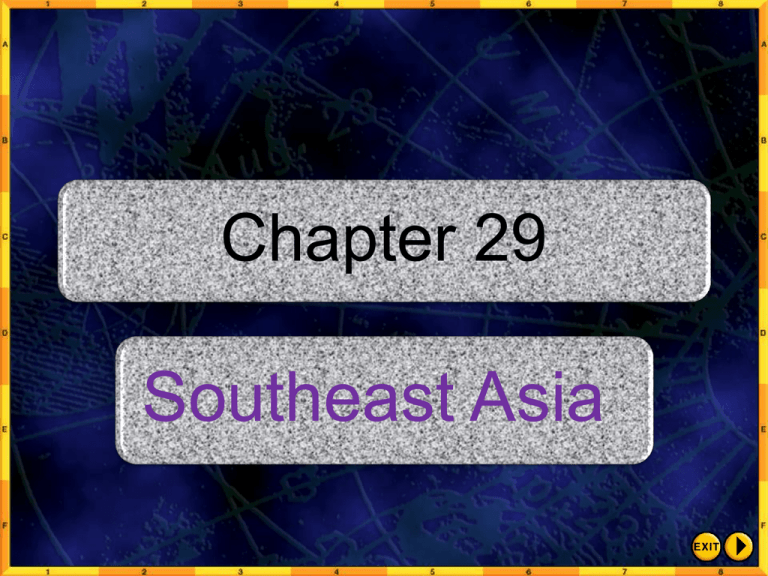
Chapter 29 Southeast Asia Chapter 29:1 Objectives 1. Describe how tectonic plates and activity from volcanoes and earthquakes formed Southeast Asia. 2. Explain why the region’s waterways are important to its people. 3. Summarize how rich natural resources affect Southeast Asia’s economy. Terms to Know • cordilleras • archipelago • insular • flora • fauna Building Geography Literacy Although the Philippines includes over 7000 islands, the archipelago’s total area is only 115,831 square miles, about the size of Arizona. The two large islands of Luzon and Mindanao account for about 66% of the country’s land area. The islands that make up the Philippines together have a coastline that measures 22,554 miles. I. Peninsulas & Islands The collision of 3 tectonic plates millions of years ago produced the peninsulas and islands of Southeast Asia. Straddling the Equator, Southeast Asia has mountainous terrain with a predominately tropical climate. A. Mainland Southeast Asia About ½ of Southeast Asia’s 11 countries are located on the mainland. Malaysia is both a mainland and an island country. Laos is the only landlocked country in the region. Mainland Nations Malaysia Laos Thailand Vietnam Cambodia Myanmar (Burma) B. Island Southeast Asia Island nations are Philippines, Brunei, Singapore, East Timor, Malaysia Indonesia. Indonesia is the largest island country. It is made up of more than 13,500 islands that span 3000 miles and two oceans, the Indian and the Pacific. Singapore consists of one large island and 50 smaller ones. The Philippines is made up of more than 7000 islands 11 of which are home to 95% of the population. Discussion Question • Why do you think so many of the region’s islands are not settled? II. Physical Features A. Mountains Southeast Asia’s many mountains create geographical and political boundaries. Some of them are active volcanoes, forming part of the Ring of Fire. Over time, mineral-rich volcanic material has broken down to provide farmers with rich, fertile soil. B. Volcanoes of Indonesia & Philippines Java, Indonesia, one of the Ring of Fire’s most active areas. Java is home to 17 of Indonesia’s 100 active volcanoes. 1883 eruption of Krakatau was catastrophic. 1991, Mt. Pinatubo, Philippines, erupted burying the surrounding area under a foot of mineral-rich volcanic ash. Rivers Southeast Asians rely on waterways for Transportation, Communication, Food. Mekong floating village Major Rivers are Irrawaddy, Myanmar, The Chao Phraya, Thailand; The Red River, Vietnam. Mekong River, Vietnam & Cambodia. Discussion Question • Compare and contrast the physical features of these islands with those of other islands you have studied, such as Great Britain, various Mediterranean islands, or Hawaii. III. Natural Resources A. Energy Sources: S.E. Asia has a plentiful supply of coal, oil and natural gas. Indonesia is a leading producer of oil and a member of OPEC. Malaysia, Vietnam, the Philippines and Brunei also have fossil fuel resources. B. Minerals & Gems Indonesia mines nickel and iron. Philippines mines copper. Malaysia mines tin. Sapphires, rubies & pearls in S.E. Asia. Myanmar has minerals and gems. C. Flora & Fauna Thailand is a leading exporter of orchids. Malaysia has much of the world’s rubber. Indonesia supplies plywood. Elephants Rhinoceroses Tigers Orangutans Cambodia Komodo dragon Indonesian lizard Bearded pig. Fishing 2500 species of fish S.E. Asians eat 2x as much fish as the rest of the world. Local fisherman must now compete with large fleets of trawlers. Fish farming is important to local economies. Vietnam Market Popular – snakehead fish Discussion Question • What are the major natural resources? • Name the different ways that Southeast Asian’s take care of their everyday needs? Chapter 29:2 Objectives • 1. Identify the weather pattern that influences Southeast Asia’s climate. • 2. List the region’s main climate types. • 3. State the main type of natural vegetation found in Southeast Asia. Terms to Know • endemic • deciduous Building Geography Literacy Malaysia includes mainland and island areas: West Malaysia, on the southern part of the Malay Peninsula; East Malaysia on the northern part of the island of Borneo. Mainland & Island Both areas have similar natural features: Coastal swamps or mangrove forests; Lowland rain forests; Interior mountains. I. Tropical Climate Regions Southeast Asia’s rain forests depend on the moisture brought by the summer monsoons blowing in from the south and west. A. Tropical Rain Forest Climate Most of Southeast Asia has a tropical rain forest climate. Temperatures average 79°F. Humidity is always high. Rainfall is between 79 and 188 inches. The rain forests feature more than 14,500 species of flowing plants. Includes peat swamp forests Mangrove swamp forests Evergreen trees B. Singapore Once entirely covered by dense rain forest Now almost entirely urbanized 80% of the trees growing there are imported Some from Central and South America. C. Tropical Savanna Climate Treecovered grasslands Alternating wet and dry seasons Parts of the Indochina Peninsula and the islands of Indonesia have a tropical savanna climate D. Humid Subtropical Climate Part of Thailand Most of Laos Humid subtropical climate With a cool dry season lasting from November to April. Northern Vietnam Myanmar Discussion Question • What geographical factor accounts for the fairly constant year-round temperatures in Southeast Asia? • Answer: the region is near the Equator, where there is little seasonal variation in the amount of sunlight or day length. II. Highlands Climate Region Highlands climate predominate in mountainous areas of and temperatures are cooler Borneo Myanmar New Guinea Discussion Question • Why did Singapore replace much of its original habitat? End of Slide Show
